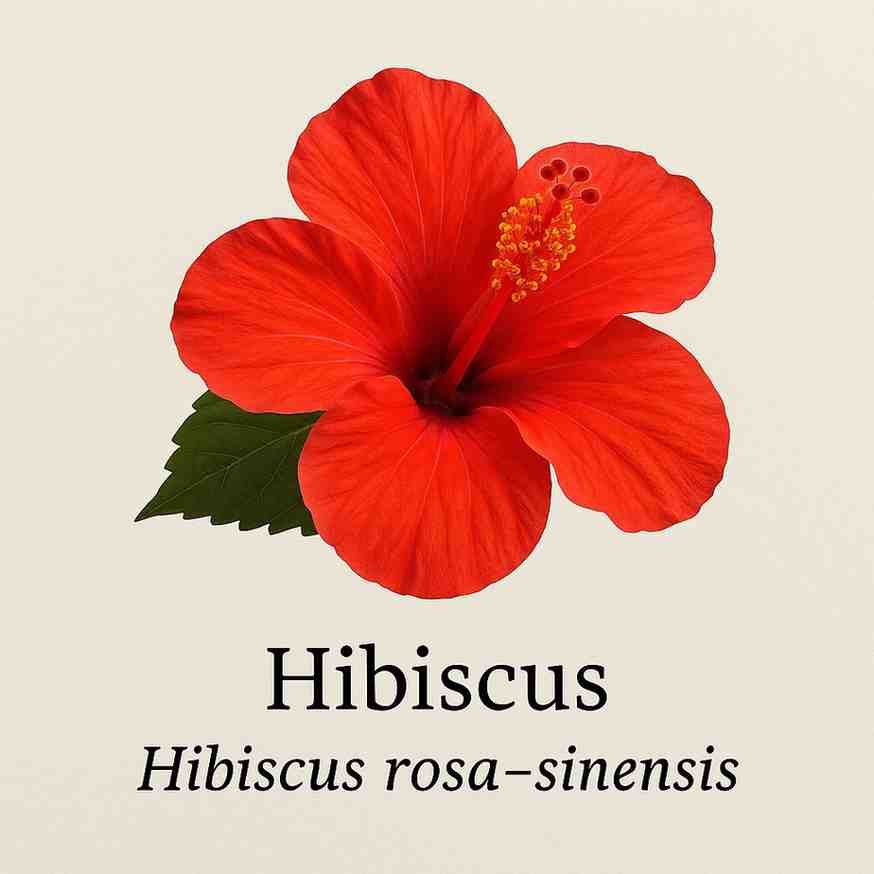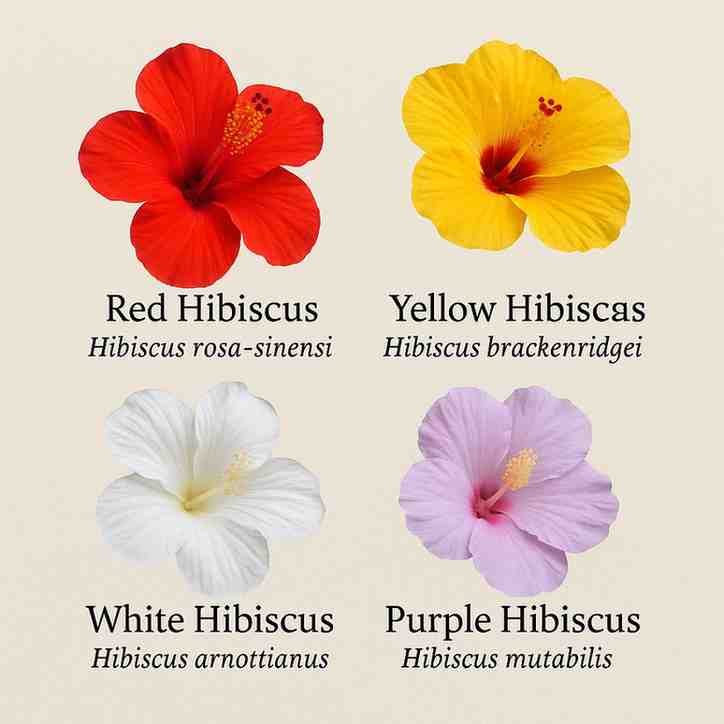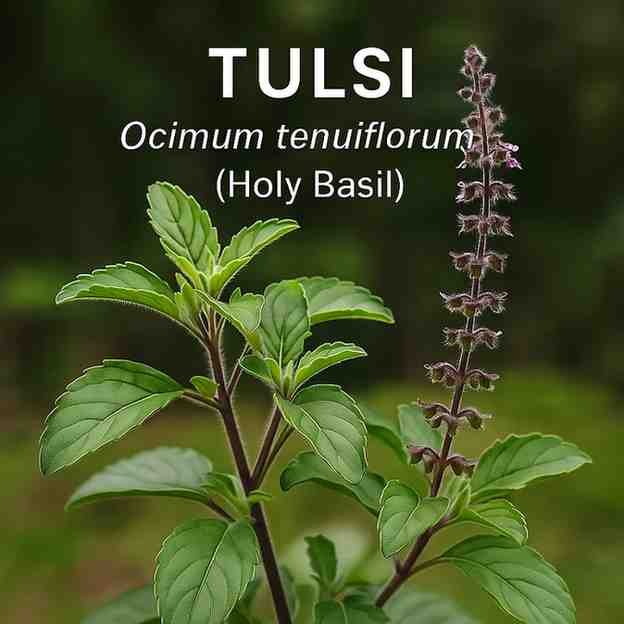What is the scientific name of hibiscus flower? The hibiscus scientific name is Hibiscus rosa-sinensis.
Native to the tropics, admired for the vibrant colors of its flowers, as well as for its health benefits and symbolic implications, the hibiscus plant can be classified as either a tree or a shrub. Flowering trees and shrubs are often popularly called China rose or Gudhal. There are many types of hibiscus flowers, grown for their beauty, herbal uses, or landscaping purposes. This article throws light on the hibiscus botanical name, scientific classification, pronunciation, benefits, and uses of this very much-adored plant.

Table of Contents
What Is the Scientific Name of Hibiscus Rose?
The scientific name of the hibiscus flower is Hibiscus rosa-sinensis.
The origin of this name is:
- Hibiscus, the genus name.
- rosa-sinensis means ‘rose of China.’
This tropical flowering plant is treasured for its beauty almost all over the world. Other common names are China Rose, Gudhal, or Sembaruthi, depending on the region and language.
How to Pronounce the Scientific Name Hibiscus
- Hibiscus: hai-BIS-kus
- rosa-sinensis: ROH-suh sy-NEN-sis
Phonetic: hai-BIS-kus ROH-suh sy-NEN-sis
Botanical Classification of the Hibiscus Plant
| Rank | Scientific Classification |
|---|---|
| Kingdom | Plantae |
| Clade | Angiosperms |
| Clade | Eudicots |
| Clade | Rosids |
| Order | Malvales |
| Family | Malvaceae |
| Genus | Hibiscus |
| Species | rosa-sinensis |
Size, Height, Age, and Growth of Hibiscus Tree
- Plant Type: Flowering shrub
- Height: This plant usually grows from 3 to 10 feet.
- Spread: Up to 5-6 feet wide
- General Age: 5 to 10 years
- Flower Size: 4 to 8 inches in diameter
- Growth Speed: Fast-growing with the right conditions
- Lifespan: Tropical perennials
Hibiscus Native Region and Habitat
Hibiscus is native to East Asia, particularly China and close tropical regions around it; now, it has spread widely across:
- South Asia
- Africa
- Central America
- Southern United States
Conditions and environment preferred:
- Terrestrial or humid tropics or subtropics
- Heat
- Intense sunshine
- Moist, well-drained soils
Types of Hibiscus Flowers
There are more than 200 species in the Hibiscus genus, with a few common types:

🟥 Red Hibiscus
Widely recognized as the most popular variety, red hibiscus (Hibiscus rosa-sinensis) plays a main role in herbal medicine.
- Red Hibiscus Scientific name: Hibiscus rosa-sinensis
- Significance: In India, and indeed throughout the world, the red hibiscus holds devotional significance, particularly in Hindu rituals honoring the goddess Kali and the god Ganesha.
- Uses: The plant is famous for making its hip tea, oil, and hair products.
🟨 Yellow Hibiscus
Hibiscus brackenridgei, the yellow hibiscus, is the state flower of Hawaii.
- Yellow Hibiscus Biological Name: Hibiscus brackenridgei
- Significance: Symbolizes happiness, sunshine, and good luck.
- Uses: Those are mostly of landscape value in tropical regions.
⚪ White Hibiscus
White hibiscus is admired for its pure, serene appearance.
- Purple Hibiscus Botanical Name: Hibiscus arnottianus
- Significance: Signifies purity, peace, and a spiritual connection.
- Uses: It is grown in gardens and temples and is known for its calming herbal tea.
🟪 Purple Hibiscus
This rare color is likely to be the result of selective breeding or hybridization.
- Purple Hibiscus Botanical name: Hibiscus syriacus
- Significance: Symbolizes mystery, knowledge, and uniqueness.
- Uses: Mostly grown for ornamental use and rarely distributed among specimen gardens.
🌈 Hybrid Varieties
Hybrid hibiscus types display a mixed range of colors, different patterns, and double-petal flowers.
- Significance: They symbolize beauty, uniqueness, and modern cultivation.
- Uses: Garden decoration, floral art, and collectors’ interest.
Medicinal Benefits and Health Uses of Hibiscus Plant
Hibiscus is not only decorative but also provides many natural health benefits considered an important ingredient in traditional medical systems such as Ayurveda and Unani.
1. Hibiscus Tea
- Lowers blood pressure
- Aids in digestion
- Detoxification for liver
- Supports weight loss
2. Hair and Skin Care Use
- Treats dandruff
- Prevents hair fall
- Adds shine and volume
- Heals minor wounds
3. Ayurvedic and Herbal Use
- Helps with pitta and kapha imbalance
- Used against anemia and urinary problems
- Poultice against swelling and skin conditions
Hibiscus in Culinary Uses
- Most often, hibiscus tea is made from dried petals and is a tangy red herbal drink.
- Jams, jellies, syrups, and sauces
- Edible petals used in salads or dried powder
- Used for Zobo drink in Nigeria, and Agua de Jamaica in Latin America.
Symbolism and Cultural Significance
The hibiscus flower holds deep symbolic value in many parts of the world:
| Culture/Region | Symbolism |
|---|---|
| India | Devotion, used in rituals |
| China | Fame, glory, delicate beauty |
| Hawaii | State flower, represents aloha |
| Egypt/Sudan | Love, hospitality (tea culture) |
Common Names of Hibiscus in Different Languages
| Language | Name |
|---|---|
| English | Hibiscus, China Rose |
| Urdu | Gudhal |
| Hindi | गुड़हल (Gudhal) |
| Tamil | செம்பருத்தி (Sembaruthi) |
| Arabic | كركديه (Karkadeh) |
| Malay | Bunga Raya |
| Chinese | 木槿花 (Mùjǐnhuā) |
How to Grow Hibiscus: Ideal Conditions
- Sunlight: 6 to 8 hours a day
- Watering: Water regularly; do not overwater
- Soil: It should be well-drained, slightly acidic
- Fertilizing: Apply balanced fertilizer whenever possible, every month in the growing season
- Containers: Can be grown in pots and pruned
Interesting Facts about Hibiscus Plant
- Butterfly and hummingbird attractors
- For natural dye
- Petals’ color changes with the pH of the soil
- Hibiscus sabdariffa is used for herbal tea, not Rosa sinensis
- Once established, hibiscus-grown plants are resilient to drought
Final Thoughts
Hibiscus rosa-sinensis exquisitely graces the landscape as a flower and is profoundly important culturally, medicinally, and ecologically. Be it scientific nomenclature, health, or the general vivacity of its uses, the hibiscus has carved its name as one of the most essential flowering plants in the world. An ageless masterpiece of nature, hibiscus perfectly combines beauty with utility.
Frequently Asked Questions (FAQ)
Q1: What is the scientific name of red hibiscus?
Hibiscus rosa-sinensis is typically red, but its scientific name remains unchanged regardless of its color.
Q2: Is hibiscus a herb or a shrub?
It’s a woody shrub, but also used in herbal remedies.
Q3: Can I grow hibiscus indoors?
Yes, if placed in a sunny window and given enough warmth and humidity.
Q4: Is hibiscus good for blood pressure?
Yes, hibiscus tea is scientifically shown to help lower blood pressure.
Q5: Is hibiscus edible?
Yes, both the petals and leaves are edible and used in culinary or medicinal recipes.

